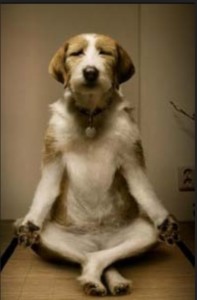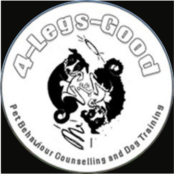
Apart from starting to meditate and learning to come back to the present and noticing the moment many, many times a day, if you would like your dog to be more relaxed it helps to start small.
Exercise:
Many people get their dog to stop and sit at every curb. Why not use this opportunity to connect your feet with the ground, feel into your body, check your lead arm and connection to your dog, pay attention to what’s going on around you, take a breath and bring yourself and your dog back to the moment before setting out on the next step? Over time, via learning the simple act of reaching the curb (going up stairs, cleaning our teeth, feeding the dog) will bring us back to the moment where we can connect with ourselves and ‘notice’ what is going on for us and our dogs.
Mindfulness and problem dogs: I have noticed that there are some, chill dogs who reduce their dog parents stress and there are some not so chill dogs that increase their dog parents stress. Many of my clients, get very stressed in certain situations when with their dogs, particularly the ones with dogs that react negatively towards other dogs they meet on walks. This behaviour is very embarrassing. Whilst what I’m talking about below is transferable to other situations, it specifically refers to these ‘dog reactive dogs’. These dogs’ owners tend to become anxious about what might happen when they meet another dog. They intuitively know that their anxiety will communicate to their dog making it even more likely that their dog will react, and this stresses the dog parent out still further. What they probably don’t know is that their intuition corresponds with the science. Basically, mammalian nervous systems will synch with other mammalian nervous systems that are nearby, including those of our dogs. This is known as co-regulation when the nervous systems that are synching are in a positive emotional state and co-dis-regulation when the synching nervous systems are in a stressed state. More often than not, dogs react negatively towards unknown dogs because they are afraid and unfortunately, when they detect that their dog parent is anxious, they jump to the conclusion that you, too, are frightened of the other dog, and hey presto, it becomes a vicious circle. In fact, some dogs only react to other dogs because of their owner’s anxiety! If you have a dog like this, notice how it feels in your body when they kick off and notice how it feels for you when you avoid a confrontation.
My work is about helping people to understand why their dog is behaving in the way that they are, letting them know what to do about it and teaching them to set up situations so that their dog is less likely to go ‘over threshold’ and react. This goes a long way towards helping the dog parent to be more relaxed and as a consequence the dog too, however, many of my clients would like to know how to further communicate to their dog that they are un-concerned by an approaching dog – and indeed even be unconcerned! This is where mindfulness can help.
Mindfulness can help you to notice the way you are feeling and help interrupt the stress response so that it is less likely to communicate down the lead and make things worse. However, just like for your dog, training will not work if you are over ‘threshold’ and already reacting.
If dog parents can learn to relax the lead arm and transmit calmness and coping to the dog – ‘you are safe with me’ then the dog will be less likely to react. Of course, just like teaching a dog to teach themselves to relax, and just as you would introduce any new training to your dog, you need to start in a quiet environment with few distractions when you are already calm and relaxed. This means at home and without even a lead, or on a walk without your dog. Only gradually will you be able to transfer the mindful relaxation that this brings to any type of stressful situation with your dog.
Exercise:
When not holding the lead:
- send attention to the jaw, then the tongue, then the neck and shoulders and practice releasing the muscles
- feel into your body, check in with the sights and sounds of the moment
- feel the connection with the ground through your feet
- take a breath
- ….and exhale….
Then repeat when you are holding the lead but without the dog:
- Relax the lead arm,
- Hold the lead lightly
Once you have the hang of this, attach the dog and repeat many times
Only start this work when you are feeling calm, you need to establish a strong ‘habit’ before having a hope in hell of using the technique in earnest. It will probably be best try a ‘stress break’ and avoid the problem situations entirely in the short term. For dogs that react to other dogs, this means, don’t take them where you know you will see other dogs. For some of my clients, this may even mean not walking the dog at all for a while or by taking them somewhere really, quiet (The environmentalist in me can’t believe it, but I sometimes suggest people drive somewhere quiet!) to give their ‘mindfulness’ training the chance to start to establish a ‘habit’. This will also allow the dog’s nervous system to re-set to ‘relax’, too.
Over time (perhaps a long time), the skill set will transfer and you will find yourself able to be calmer in proximity to other dogs and this will help your dog to relax too.
Dogs would naturally indulge in mindfulness and turn towards what feels good and away from what doesn’t – but they live with us! Slow down, notice, practice, have quiet times. Mindfulness helps reset the nervous systems of dogs and people thereby cultivating positive neurotransmitters like serotonin and engendering immersion in the more positive emotional states.
